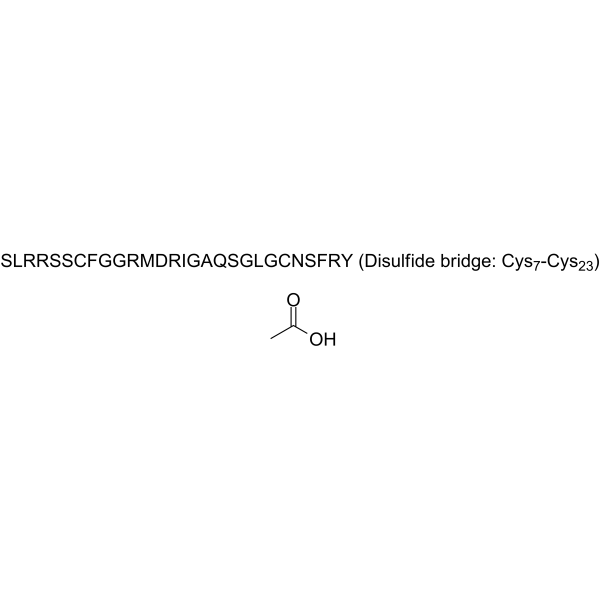
ANP (1-28), human, porcineANP(1-28)
CAS No. 1366000-58-9
ANP (1-28), human, porcineANP(1-28) ( Atrial Natriuretic Peptide (ANP) (1-28), human, porcine Acetate )
Catalog No. M29918 CAS No. 1366000-58-9
Atrial natriuretic peptide (ANP), a stimulator of particulate guanylate cyclase, has been found to protect against reoxygenation-induced hypercontracture in isolated cardiomyocytes by increasing cyclic guanosine monophosphate synthesis; ANP also contributes to stimulation of lipolysis during repeated bouts of exercise and in the control of lipolysis during exercise.
Purity : >98% (HPLC)
 COA
COA
 Datasheet
Datasheet
 HNMR
HNMR
 HPLC
HPLC
 MSDS
MSDS
 Handing Instructions
Handing Instructions
| Size | Price / USD | Stock | Quantity |
| 2MG | 345 | In Stock |


|
| 5MG | 732 | In Stock |


|
| 10MG | 972 | In Stock |


|
| 25MG | 1467 | In Stock |


|
| 50MG | 1962 | In Stock |


|
| 100MG | 2673 | In Stock |


|
| 200MG | Get Quote | In Stock |


|
| 500MG | Get Quote | In Stock |


|
Biological Information
-
Product NameANP (1-28), human, porcineANP(1-28)
-
NoteResearch use only, not for human use.
-
Brief DescriptionAtrial natriuretic peptide (ANP), a stimulator of particulate guanylate cyclase, has been found to protect against reoxygenation-induced hypercontracture in isolated cardiomyocytes by increasing cyclic guanosine monophosphate synthesis; ANP also contributes to stimulation of lipolysis during repeated bouts of exercise and in the control of lipolysis during exercise.
-
DescriptionAtrial natriuretic peptide (ANP), a stimulator of particulate guanylate cyclase, has been found to protect against reoxygenation-induced hypercontracture in isolated cardiomyocytes by increasing cyclic guanosine monophosphate synthesis; ANP also contributes to stimulation of lipolysis during repeated bouts of exercise and in the control of lipolysis during exercise.(In Vitro):Atrial natriuretic peptide (ANP) is a diuretic, natriuretic, and vasodilatory peptide hormone originally isolated from mammalian hearts. In cultured porcine endothelial cells the inhibition by porcine ANP (1-28) of immunoreactive endothelin-1 secretion after stimulation with Angiotensin II (Ang II) is paralleled by an increase in the cellular cGMP level. Porcine ANP (1-28) strongly inhibits immunoreactive endothelin-1 secretion in porcine aorta after stimulation with Ang II. ANP is a cardiac hormone involved in electrolyte and fluid homeostasis. The inhibition by ANP of endothelin-1 secretion stimulated by angiotensin II (ANGII) and thrombin using cultured human umbilical-vein endothelial cells. Human ANP (1-28) inhibits immunoreactive (ir)-endothelin-1 secretion and increases cyclic GMP in the human umbilical-vein endothelial cells. In glomeruli from normal rats, Human 125I-ANP (1-28) binds to a single population of high affinity receptors with a mean equilibrium dissociation constant of 0.46 nM. Human ANP (1-28) binds to the glomerular ANP receptor with high affinity stimulated cGMP accumulation. Human ANP (1-28) markedly stimulates cGMP generation, but not cAMP generation in normal rat glomeruli.
-
SynonymsAtrial Natriuretic Peptide (ANP) (1-28), human, porcine Acetate
-
PathwayOthers
-
TargetOther Targets
-
Recptor——
-
Research Area——
-
Indication——
Chemical Information
-
CAS Number1366000-58-9
-
Formula Weight3140.5
-
Molecular FormulaC127H203N45O39S3.C2H4O2
-
Purity>98% (HPLC)
-
Solubility——
-
SMILES——
-
Chemical Name
Shipping & Storage Information
-
Storage(-20℃)
-
ShippingWith Ice Pack
-
Stability≥ 2 years
Reference
Kohno M, et al. Atrial and brain natriuretic peptides inhibit the endothelin-1 secretory response to angiotensin II in porcine aorta. Circ Res. 1992 Feb;70(2):241-7.
molnova catalog


related products
-
Imidazole
Imidazole is a planar 5-membered ring and a highly polar compound. It has been used extensively as a corrosion inhibitor. Imidazole is incorporated into many important biological molecules.
-
(+)-Peusedanol
(+)-Peusedanol is a natural product isolated from Peucedanumjaponicum.
-
γ-L-Glutamyl-L-alani...
γ-L-Glutamyl-L-alanine composed of gamma-glutamate and alanine?is the substrate of CRF21 (gamma-Glutamylcyclotransferase GGCT).



 Cart
Cart
 sales@molnova.com
sales@molnova.com


